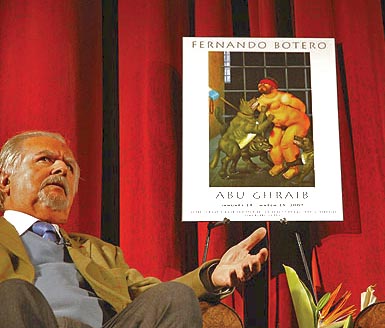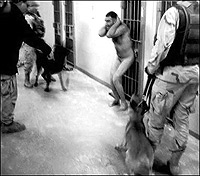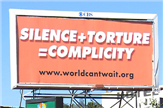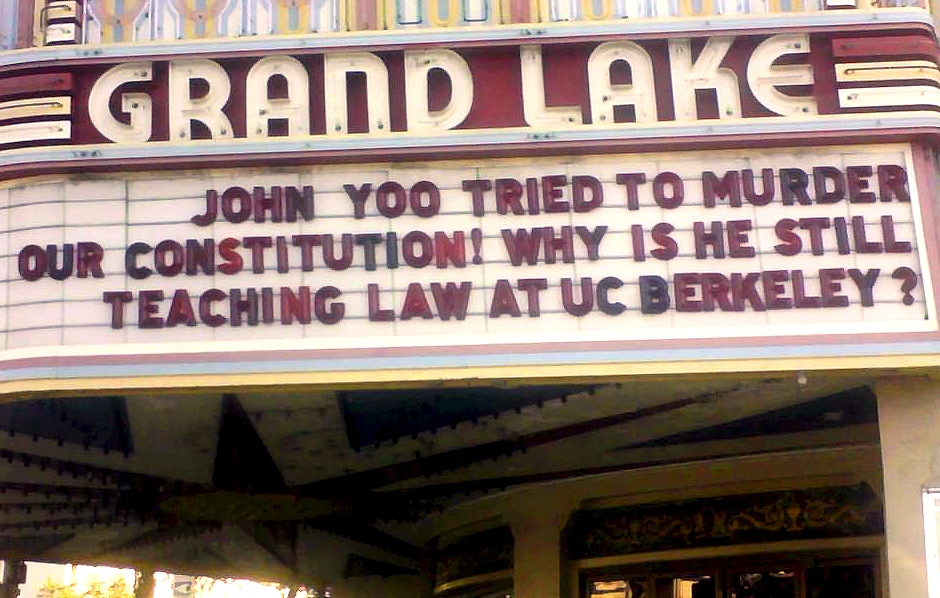Are US Officials Guilty of War Crimes?by
Andy Worthington
Will
the Bush administration be held accountable for war crimes? The answer
ought to be yes, if the verdict of the Senate Armed Services Committee
Inquiry into the Treatment of Detainees in US Custody is to mean
anything. The bipartisan report, released on December 11 by senators
Carl Levin and John McCain, concluded that the torture and abuse of
prisoners was the direct result of policies authorized or implemented
by senior officials within the current administration, including
President George W. Bush, former Defense Secretary Donald Rumsfeld, and
Vice President Dick Cheney's former legal counsel (and now chief of
staff) David Addington.
Since
the scandal of the abuse of prisoners at Abu Ghraib prison in Iraq
broke in April 2004, over a dozen investigations have identified
problems concerning the treatment of prisoners in Iraq, Afghanistan and
Guantanamo, but until now no official report has looked up the chain of
command to blame senior officials for authorizing torture and
instigating abusive policies. The Bush administration has been able to
maintain, as it did in the wake of the Abu Ghraib scandal, that any
abuse was the result of the rogue activities of "a few bad apples."
This
is now untenable. As the report states: "The abuse of detainees in US
custody cannot simply be attributed to the actions of 'a few bad
apples' acting on their own. The fact is that senior officials in the
United States government solicited information on how to use aggressive
techniques, redefined the law to create the appearance of their
legality, and authorized their use against detainees. Those efforts
damaged our ability to collect accurate intelligence that could save
lives, strengthened the hand of our enemies, and compromised our moral
authority."
Though containing
little new information, the report is damning in its revelation of how
senior officials sought out and approved the reverse engineering of
techniques taught in the US military's SERE schools (Survival, Evasion,
Resistance, Escape) for use on prisoners captured in the "war on
terror." These include "stripping detainees of their clothing, placing
them in stress positions, putting hoods over their heads, disrupting
their sleep, treating them like animals, subjecting them to loud music
and flashing lights, and exposing them to extreme temperatures." In
some circumstances, the measures also included waterboarding, a
notorious torture technique which involves controlled drowning.
After
noting that these techniques were taught to train personnel "to
withstand interrogation techniques considered illegal under the Geneva
Conventions," and that they are "based, in part, on Chinese Communist
techniques used during the Korean war to elicit false confessions," the
authors laid out a compelling timeline for the introduction of the
techniques, beginning with a crucial memorandum issued by Bush on
February 7, 2002. This stated that the protections of the Geneva
Conventions, which the authors noted "would have afforded minimum
standards for humane treatment," did not apply to prisoners seized in
the "war on terror."
Having
established Bush's role as the initial facilitator of abuse, the report
then implicated those directly responsible for implementing torture,
explaining how Pentagon general counsel William J. Haynes II began
soliciting advice from the agency responsible for SERE techniques in
December 2001, and how Addington, Justice Department legal adviser John
Yoo, and White House counsel Alberto Gonzales attempted to redefine
torture in the notorious "Torture Memo" of August 2002. The memo
claimed that the pain endured "must be equivalent to the pain
accompanying serious physical injury, such as organ failure, impairment
of bodily function, or even death."
The
authors also noted how Rumsfeld approved the use of SERE techniques at
Guantanamo in December 2002 (after Haynes had consulted with other
senior officials), and explained how the techniques migrated to
Afghanistan in January 2003, and were implemented by Lieutenant General
Ricardo Sanchez, the commander of coalition forces in Iraq, in
September 2003.
Even so,
the report is not without its faults. The authors carefully refrained
from ever using the words "torture" or "war crimes," which is a
considerable semantic achievement, but one that does little to foster a
belief that the officials involved will one day be held accountable for
their crimes. They also, curiously, omitted all mention of Vice
President Dick Cheney, and ignored the importance of the presidential
order of November 2001, which authorized the capture and indefinite
detention of "enemy combatants," even though Barton Gellman of The
Washington Post has established that Cheney played a significant role
in this and all the other crucial documents that led to the torture and
abuse of detainees.
Responses
in the US media have been mixed. Oddly, most major media outlets chose
to focus solely on Rumsfeld's responsibility for implementing abusive
techniques. More thoughtful commentators have questioned whether Barack
Obama would pursue those responsible, noting that he will be unwilling
to antagonize Republicans, whose support he needs to tackle the
economic crisis, and that many Democrats in Congress knew about the
administration's policies, and in some cases were involved in approving
them. A recent article in The Nation noted that such complicity made
"an unfettered review seem unlikely," but the article also noted, more
hopefully: "A growing body of legal opinion holds that Obama will have
a duty to investigate war crimes allegations and, if they are found to
have merit, to prosecute the perpetrators."
As
of December 17, those concerned with pursuing Bush administration
officials for war crimes can at least be assured that the perpetrators
now include Cheney. In an interview with ABC News, the vice president
stuck to a now-discredited script, declaring "we don't do torture, we
never have," but admitted for the first time that he knew about the use
of waterboarding on a handful of "high-value detainees," and that he
considered its use in their cases "appropriate."
Only
time will tell if Cheney's admission will be regarded as a stalwart
defense of national security, or as the last defiant gesture of a war
criminal.
 On September 22, 2009, the University of California, Berkeley Art Museum (BAM) will welcome Fernando Botero's generous gift of 26 paintings and 30 drawings from his Abu Ghraib series to Berkeley and to the museum's permanent collection. Valued in the multiple millions -- although Botero has always said they would never be for sale -- this is the largest gift in BAM's history and one of the largest in the history of any American university collection. Botero began work on this series in the summer of 2004 after reading Seymour Hersh's revelatory and disturbing report on torture and abuse at Abu Ghraib in The New Yorker. His images are not strictly documentary, not a translation of the infamous and much reproduced snapshots into another media. They are a great artist's effort "to make invisible things visible," to represent and thereby interpret, through a new visual vocabulary, the outrages that had been perpetrated on Iraqi prisoners in American custody. The benign and gently grotesque figures for which Botero is famous have become dark and malignly grotesque figures of the body humiliated and in pain.
On September 22, 2009, the University of California, Berkeley Art Museum (BAM) will welcome Fernando Botero's generous gift of 26 paintings and 30 drawings from his Abu Ghraib series to Berkeley and to the museum's permanent collection. Valued in the multiple millions -- although Botero has always said they would never be for sale -- this is the largest gift in BAM's history and one of the largest in the history of any American university collection. Botero began work on this series in the summer of 2004 after reading Seymour Hersh's revelatory and disturbing report on torture and abuse at Abu Ghraib in The New Yorker. His images are not strictly documentary, not a translation of the infamous and much reproduced snapshots into another media. They are a great artist's effort "to make invisible things visible," to represent and thereby interpret, through a new visual vocabulary, the outrages that had been perpetrated on Iraqi prisoners in American custody. The benign and gently grotesque figures for which Botero is famous have become dark and malignly grotesque figures of the body humiliated and in pain.

